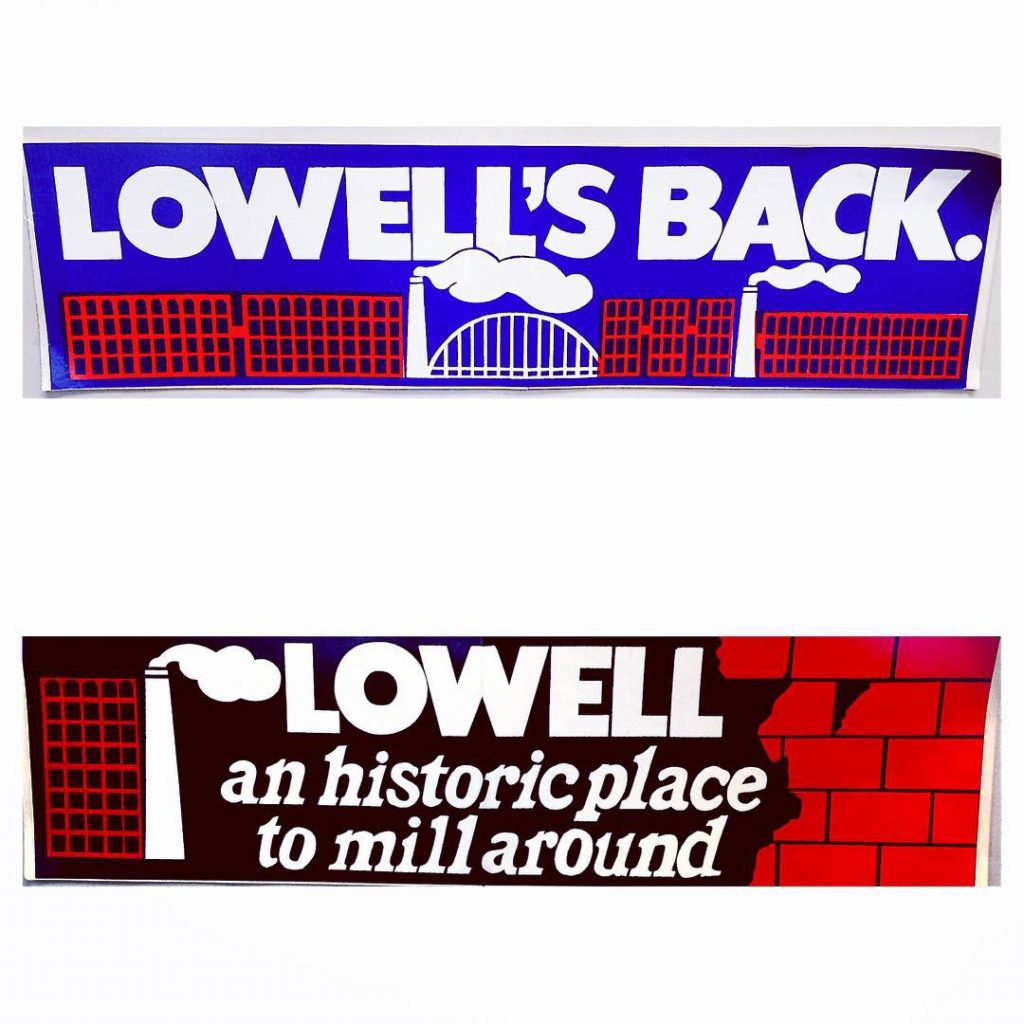MarkVan Der Hyde is one of the curators for the upcoming exhibition Branding Lowell: A History of Local Design which opens on March 24 at the Mogan Cultural Center in Lowell. In this post, he tells of how the project came about the unique design history of Lowell, Massachusetts.
As you go about your day about your city, you undoubtedly make use of directional or informational signage or see a logo or two. Have you ever stopped to think about who created them, when they were created, and why particular images were chosen to represent the city?
These questions are at the core of our exhibit, Branding Lowell, which opens March 24th at 3 pm at the Mogan Cultural Center in Lowell. Lowell, Massachusetts is a unique city. It was founded as one of the first planned textile towns in New England. As that industry came and went, the city was at a crossroads. A local leader, Patrick Mogan, envisioned using the well-preserved bones of that defunct industry to create a living classroom – an Urban National Park. He and other like-minded people such as Senator Paul Tsongas eventually succeeded and in 1978 Lowell National Historical Park was signed into law by President Jimmy Carter. This milestone, coupled with a constant stream of immigrants from various cultures has made Lowell a very different place than other post-industrial cities in New England.
With perpetual change and the passage of time comes a lot of graphic design and related marketing to support it. When viewed together, this body of work gives a fresh visual timeline to stand beside the more well known Lowell narratives.
This exhibit has its roots in two sets of objects that endured against the passage of time. The first was a set of bumper stickers that were shared years ago by our friend and colleague Christine Bruins at Lowell National Historical Park via Instagram. She happened across these in an old file cabinet in a City of Lowell office. It proudly states the revitalization message “Lowell’s Back” along with strong hand-illustrated artwork.

Vintage Lowell Bumper Stickers
The second was a plaque on a former orphanage and Franco-American grade school. At the time we didn’t know the vintage or who had done it but were fascinated by the interesting type and logos along the bottom.

That graphic artist was Michael Sand – he worked on many projects as part of the consulting team focused on bringing a National Park to Lowell, from around 1974 up until the early 1980’s.
The stickers came later, in 1978, but were part of a city project to test which design would sell more stickers.
We have spent the past year unraveling the story of Lowell around those first glimmers of this lead. Who else worked in that capacity over the years? Are the things they created still in use? Where do the city’s current most popular and visible logos have their roots? Answering all of these questions has taken us deep into the Lowell National Historical Park, the archives of UMass Lowell Libraries Center for Lowell History, and the annals of the Lowell Sun Newspaper.
The end result is a system categorized by date and color to ease the process of navigating such a broad time frame. We endeavored to track down and identify graphic artists wherever possible and have listed them along with brief descriptions and additional context.

An excerpt from the Branding Lowell exhibit panels
Creative process artifacts
While doing paper and web-based research is a given, some of our best breaks came through just asking around. Through a friend of ours Ashley Tran at local business Little Delights Bakery, we met Bill Bradbury, who was her Graphic Design professor at UMass Lowell. Through him, we were able to identify designers behind not one, not two, not even three, but four of our featured logos. This lucky break touched all aspects of our planned exhibit – one of those designers, Brian Trainor, had kept all of his original sketches from the projects, which had taken place up to 20 years ago. This allowed our object curation team to include these in the artifact cases and show process that went into making the final products.

Selection of original pencil sketches. On loan to LNHP courtesy artist Brian Trainor
Working with graphic artists like Trainor has been a very interesting process. Of the over 50 artists featured in the exhibit, about half of them were still local or available to discuss the projects first hand over the phone or via email. Sadly, several others had passed away in the intervening years. In the case of Michael Sand, who had passed in 2013, we reached out to his family and found that his daughter Jess and Zoe were digitizing his personal archives. They provided invaluable information to help our team better understand the breadth of his work in the late 1970’s with “The Lowell Team.” We, in turn, were also able to share our research to provide them more context on what they had.

Michael Sand leading a workshop. © Michael Sand Estate, michaelsand.com

Lowell Team planning documents. © Michael Sand Estate, michaelsand.com
We are excited to share the experience of discovery that this exhibit brought us – while community members will have a new lens to view things they see every day, new visitors will have a new entry point into the history of Lowell. If nothing else, we hope our work causes you to pause the next time you look at your own town or city’s logo and give some thought to how it came into being.
Mark Van Der Hyde is a digital project manager who enjoys reading plaques and exploring New England with his wife and kids. He is one of four co-curators for the exhibit “Branding Lowell.”